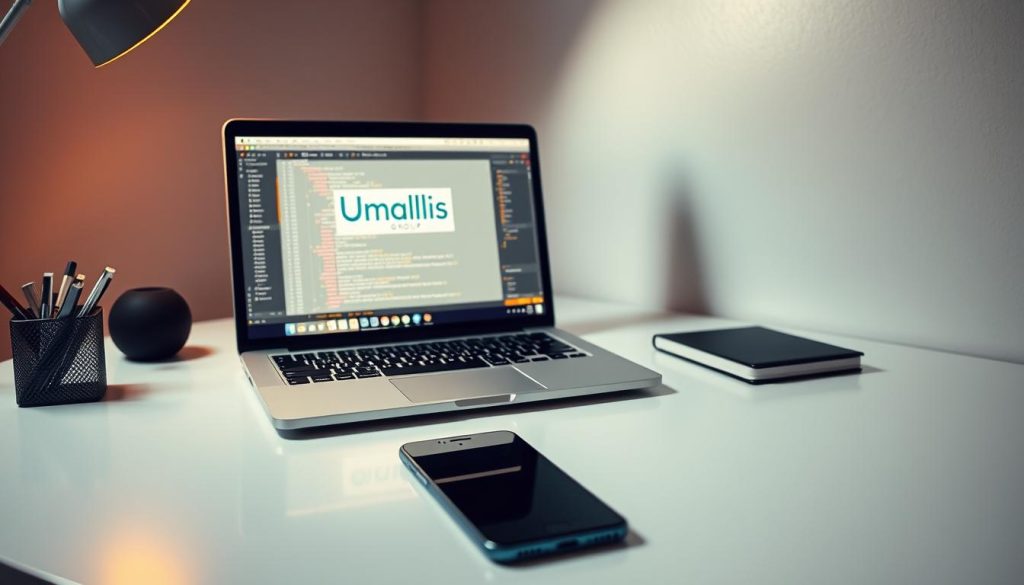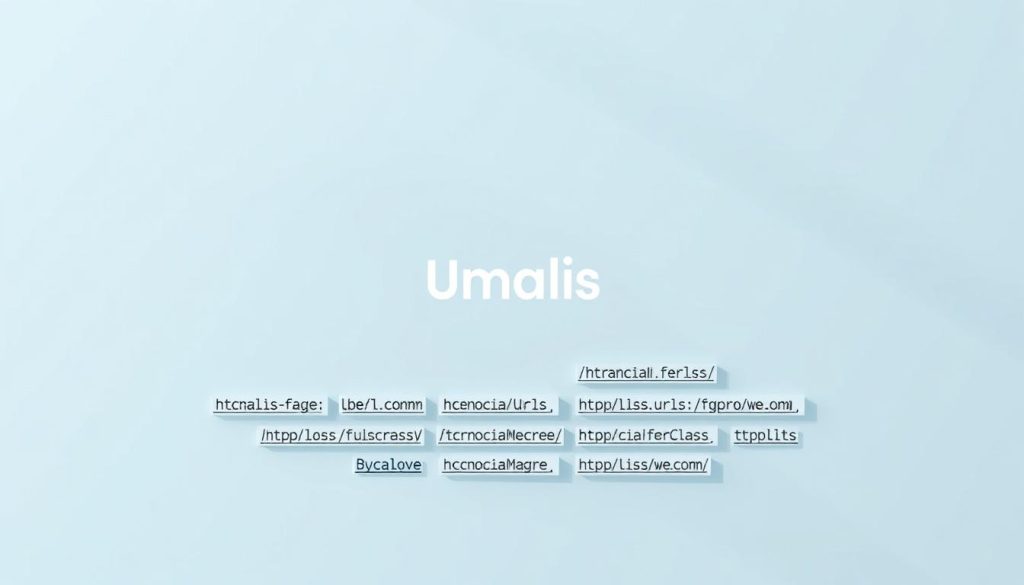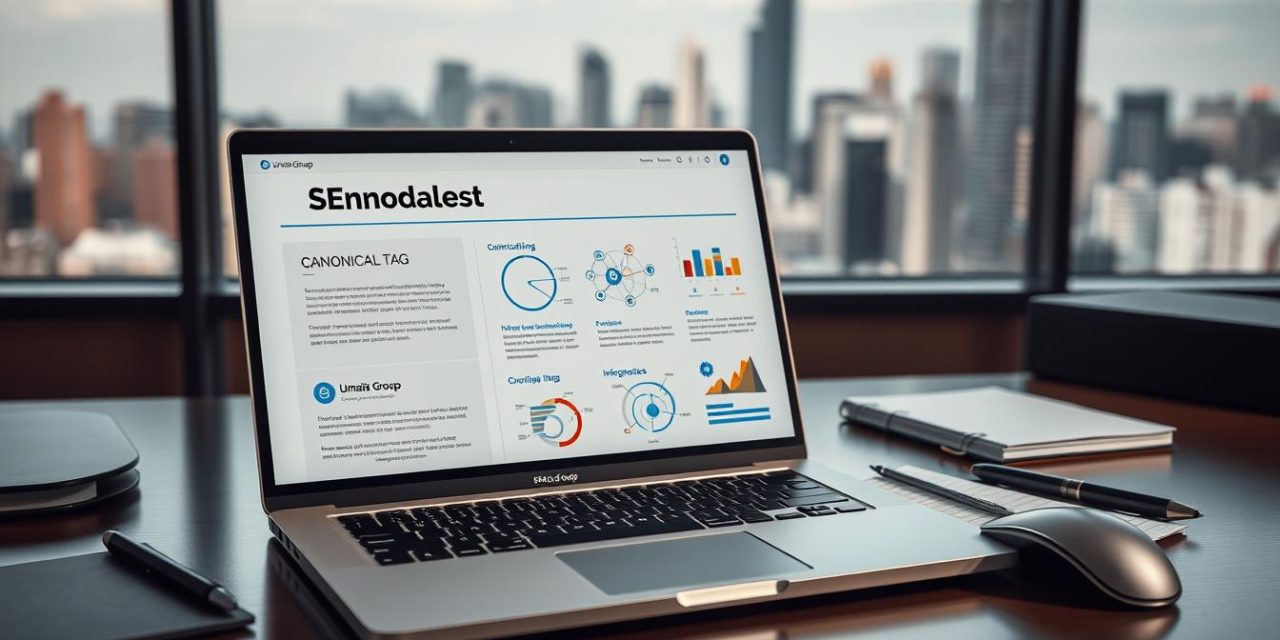Have you ever felt your hard-earned search rankings slip away because search engines couldn’t tell which version of your content mattered most? I’ve been there. Early in my career, I watched duplicate pages split our website’s authority like scattered puzzle pieces. That’s when I discovered how a single HTML element could transform chaos into clarity.
Modern websites often create multiple URLs for the same content. Dynamic systems, filters, or CMS platforms generate variations that confuse algorithms. Without clear guidance, search engines might index the wrong page or dilute your ranking power across duplicates.
This is where canonical tags shine. They act as digital signposts, telling crawlers which version to prioritize. Google Search Central confirms these tags consolidate ranking signals, boosting your SEO effectiveness. While not mandatory, they’re like insurance for your site’s visibility.
We’ll show you how to implement them strategically. You’ll learn to maintain clean site architecture, optimize crawl budgets, and protect your content’s search position. Whether you’re managing an e-commerce platform or a blog, these techniques adapt to your needs.
Table of Contents
Key Takeaways
- Canonical tags prevent duplicate content issues by specifying preferred page versions
- They help consolidate website authority for stronger search rankings
- Proper implementation improves how search engines crawl and index your site
- Dynamic websites benefit most from canonicalization strategies
- Google treats canonical tags as strong suggestions, not absolute commands
Introduction to Canonical Tags
Modern websites often create multiple pathways to the same content. Product filters, session IDs, and CMS-generated variations can produce dozens of URLs for identical pages. This digital maze confuses search engines and weakens your SEO efforts.
What Are Canonical Tags?
These HTML elements act as digital librarians for your website. The <link rel="canonical"> tag sits in your page’s head section, pointing search engines to the definitive version of your content. Google’s official documentation states: « Specifying a canonical helps prevent duplicate content issues. »
Built using simple syntax, this element declares: <link rel="canonical" href="https://yourdomain.com/primary-page"/>. It follows standards outlined in RFC 6596, making it universally recognized by major search platforms.
Why They Matter in Modern SEO
Dynamic websites generate URL variations faster than most teams can track. A single product page might have versions for different colors, sizes, or sorting preferences. Without clear direction, search engines might:
- Index duplicate pages instead of your preferred URL
- Split ranking signals across multiple versions
- Waste crawl budget on unimportant pages
Proper implementation ensures your chosen page receives full credit for backlinks and user engagement metrics. It’s particularly crucial for e-commerce sites and content hubs managing large inventories or article networks.
Importance of Canonical Tags in SEO

Duplicate pages can silently sabotage your SEO efforts. When multiple URLs display identical or similar content, search engines struggle to identify which version deserves visibility. This confusion weakens your site’s authority and creates unnecessary competition between your own pages.
Avoiding Duplicate Content Issues
Modern websites generate duplicate content through common features like product filters, session IDs, or mobile variants. Without clear guidance, search engines might:
- Index less relevant pages
- Split traffic across multiple URLs
- Lower rankings for your primary content
Canonical tags act as traffic directors, steering crawlers toward your chosen page. Google’s John Mueller confirms: « Proper canonicalization helps our systems understand your preferred version. » This prevents diluted rankings and preserves your crawl budget for critical pages.
Consolidating Link Equity and Ranking Signals
Backlinks pointing to duplicate pages fragment your site’s authority. Imagine ten versions of a product page each earning five links—your main URL misses 45 potential boosts. Canonical tags merge this equity into one powerful page.
Search algorithms also combine engagement metrics from duplicates. Bounce rates, time-on-page, and social shares strengthen your canonical version. This unified approach helps your content climb rankings faster while maintaining consistent user experiences.
How Canonical Tags Work
Ever wonder how search engines untangle technical SEO puzzles? The answer lies in strategic signaling. Three primary methods guide crawlers to your preferred content version, each with distinct strengths and applications.
The Role of the <link rel= »canonical »> Element
This HTML component acts as your site’s primary navigation tool. Placed within the <head> section, it uses simple code: <link rel="canonical" href="https://example.com/main-page">. Google treats this as a strong recommendation, prioritizing the specified URL for indexing.
For non-HTML files like PDFs, use HTTP headers. A rel= »canonical » header tells crawlers which document version matters most, even without HTML markup. This method works seamlessly with API-driven platforms and digital asset management systems.
Using HTTP Headers and Sitemaps for Canonicalization
Search engines evaluate signals through a clear hierarchy:
| Method | Signal Strength | Best For |
|---|---|---|
| 301 Redirects | Strongest | Permanent URL changes |
| rel= »canonical » Element | High | HTML pages with duplicates |
| Sitemap Entries | Supporting | Confirming primary URLs |
Combine these approaches for maximum impact. Sitemaps help verify your preferences, while HTTP headers extend coverage to non-web documents. Always ensure your chosen URL returns a 200 status code—broken links weaken trust in your signals.
Identifying Duplicate Content and URL Variations
Your website might be leaking SEO value without you realizing it. Common technical setups create multiple paths to identical pages, splitting your authority across unnecessary duplicates. A single product page could have 50+ URL variations from filters, session IDs, or regional settings.
- Protocol mismatches: HTTP vs HTTPS or www vs non-www versions
- Parameter overload: Tracking codes like ?utm_source or sorting options (?sort=price)
- CMS quirks: Default index.php pages or trailing slash inconsistencies
E-commerce platforms multiply these issues. A blue widget page might generate URLs for size filters, color options, and inventory alerts. Each variation competes with your main product URL, confusing search algorithms.
Use this audit checklist to uncover hidden duplicates:
| Method | Best For | Tools |
|---|---|---|
| Manual checks | Small sites | Site: search operators |
| Automated crawls | Large websites | Screaming Frog, DeepCrawl |
Look for pages with matching title tags or near-identical content clusters. One publishing client found 12,000 duplicate URLs from a single calendar widget – fixing them boosted organic traffic by 37% in eight weeks.
Implementing Canonical Tags on Your Website

Ready to take control of your site’s SEO health? Proper implementation of canonical signals requires precision and strategy. Let’s break down the most effective methods to ensure your preferred pages receive full search visibility.
Step-by-Step Guide for Manual Implementation
For developers comfortable with code, manual placement offers granular control. Open your page’s HTML and locate the <head> section. Insert this line:
<link rel="canonical" href="https://yourdomain.com/main-page" />
Ensure the URL matches your preferred version exactly. Case sensitivity matters—Product-Page and product-page appear as different addresses to crawlers. Double-check using browser developer tools (F12) to confirm proper placement.
Utilizing SEO Plugins and CMS Settings
Platforms like WordPress simplify the process through plugins. Yoast SEO automatically generates canonical references based on your permalink structure. For Shopify stores:
- Navigate to Online Store > Themes
- Edit theme code under « Actions »
- Add canonical logic to product template files
Non-HTML files require different handling. Add this to your .htaccess file for PDFs:
Header set Link "<https://yourdomain.com/main-file.pdf>; rel=\"canonical\""
Always verify implementations through Google Search Console’s URL Inspection Tool. Correct setups show « Canonical: user-declared » with your chosen URL. Regular audits prevent signal conflicts as your site evolves.
Canonical Tags Best SEO Practices

Mastering canonical tags requires more than basic implementation—it demands precision in execution. Google’s Search Advocate John Mueller emphasizes: « Self-referencing canonicals clarify your preferred version, even when duplicates don’t exist. » Let’s explore techniques to maximize their impact.
Self-Referencing Canonical Tags and Absolute URLs
Every page should act as its own authority. Self-referencing tags function like digital ID cards, confirming a page’s primary status. For example:
- Homepage:
<link rel="canonical" href="https://www.example.com/"> - Blog post:
<link rel="canonical" href="https://www.example.com/blog/post-title">
Absolute URLs eliminate guessing games. Relative paths like /blog/post-title can break when pages load through different protocols or subdomains. Always specify:
| Recommended Format | Risk if Ignored |
|---|---|
| https://www.example.com/page | Mixed content warnings |
| Consistent trailing slashes | Duplicate /page vs /page/ |
| Lowercase URLs | Case-sensitive duplicates |
Follow these formatting rules:
- Match your site’s preferred HTTPS/WWW configuration
- Avoid uppercase letters in paths
- Use hyphens instead of underscores in URLs
Common pitfalls include creating canonical chains (A→B→C) or pointing to blocked pages. Regular audits with tools like Screaming Frog help maintain signal clarity. Proactively apply tags to high-value pages before duplication issues arise—prevention trumps correction in SEO.
Troubleshooting and Common Mistakes
Even seasoned SEO professionals encounter technical hiccups when managing URL signals. One misconfigured element can derail months of optimization work, leaving search engines unsure which pages to prioritize.
Avoiding Canonical Loops and Chains
Multi-step references create confusion. A page pointing to B, which then points to C, dilutes authority like a game of telephone. Always link directly to your preferred version—search algorithms prefer clear hierarchies over convoluted paths.
Common pitfalls include:
- Declaring multiple URLs in a single page’s head section
- Referencing pages blocked by robots.txt or noindex directives
- Using relative URLs that break during site migrations
Ensuring Proper Placement in the HTML Head
Search crawlers only recognize signals within the <head> section. A misplaced tag becomes invisible, like a road sign buried underground. Use browser developer tools (Ctrl+Shift+I) to verify positioning.
Conflicts arise when other directives contradict your preferences. For example:
| Conflict Type | Resolution Strategy |
|---|---|
| Canonical vs 301 redirect | Redirects override tags—remove redundant signals |
| Canonical vs noindex | Search engines prioritize noindex instructions |
Regular audits using Google Search Console’s Coverage Report uncover implementation errors. Bulk fixes through CMS templates or regex-based tools prevent recurring issues as your site scales.
Advanced Canonicalization Techniques
When managing multiple websites, canonicalization becomes a strategic chess game. Large organizations often juggle syndicated content, regional domains, or partner sites sharing similar products. This complexity demands precision to maintain search visibility while avoiding self-competition.
Cross-Domain SEO Consolidation
Cross-domain canonical tags guide search engines to prioritize content across different websites. Use this method when:
- Republishing articles on industry platforms
- Managing sister brands with overlapping inventory
- Syndicating press releases or product data
Google’s guidelines recommend HTTPS URLs as preferred versions unless technical limitations exist. Pair canonical tags with hreflang annotations for international sites—this tells algorithms which language or regional variant to display.
Systematic Auditing for Enterprise Sites
Large-scale audits require specialized tools and processes. Follow this three-step approach:
- Run site crawls using Screaming Frog to detect conflicting signals
- Analyze Google Search Console’s International Targeting reports
- Validate HTTPS implementations with SSL checker tools
For news publishers, combine canonicals with pagination tags to manage article series. E-commerce platforms should audit product variants monthly—dynamic filters often create unexpected duplicates.
Pro tip: Bookmark our comprehensive SEO audit checklist for recurring maintenance tasks. Set automated alerts in platforms like Moz Pro to catch canonical errors before they impact traffic.
Integrating Canonical Tags
Just as a skilled captain charts the clearest course through shifting waters, strategic canonical signals guide search engines to your most valuable content. These invisible markers streamline your site’s SEO efforts, ensuring every ranking boost flows to the right destination.
Effective integration starts with consistency. Audit your site monthly using tools like Screaming Frog to catch new duplicates. Pair this with Google Search Console to monitor how algorithms interpret your signals. For teams managing multiple platforms, automated alerts save hours while protecting visibility.
Remember: proper implementation isn’t just technical—it’s strategic. Consolidate authority by directing crawlers to pages that convert. Avoid splitting traffic between near-identical URLs, especially on dynamic sites. Need deeper insights? Explore advanced SEO techniques that complement your canonical strategy.
Your efforts today create lasting stability. By maintaining clean architecture and clear priorities, you protect your search presence while building trust with both users and algorithms. That’s how professionals turn technical details into career security.
FAQ
How do canonical tags improve SEO performance?
They help search engines like Google identify the primary version of duplicate pages, consolidating ranking signals and preventing diluted visibility. This strengthens your site’s authority for key content.
What happens if I don’t fix duplicate URL variations?
Unresolved duplicates can split traffic, reduce crawl efficiency, and trigger penalties for low-quality content. Tools like Screaming Frog or Semrush help detect these issues early.
Can I use relative paths in canonical tags?
No. Always use absolute URLs (e.g., https://yourdomain.com/page) to avoid confusion. Relative paths like /page may not resolve correctly across devices or protocols.
Do canonical tags work across different domains?
Yes. Cross-domain canonicalization directs search engines to treat content on external sites as copies of your original page. This is useful for syndicated articles or multi-regional sites.
How do plugins like Yoast SEO handle canonicalization?
They automate tag insertion in CMS platforms like WordPress, reducing manual coding errors. However, always verify the output HTML to ensure tags align with your strategy.
What’s a common mistake with canonical implementation?
Creating loops by accidentally canonicalizing Page A to Page B and vice versa. Use Google Search Console’s Coverage Report to identify such crawl errors quickly.
Should paginated pages use canonical tags?
No. Use rel="prev" and rel="next" for pagination instead. Canonical tags here could mislead search engines about the content hierarchy.
Can HTTP headers replace HTML canonical tags?
For non-HTML files (PDFs, images), yes. Include Link: rel="canonical" in the header. For webpages, HTML tags remain the standard method.





